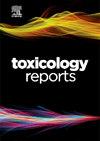2C和NBOMe药物的毒理学分析——是否有滥用的可能?
Q1 Environmental Science
引用次数: 0
摘要
吸毒是一个普遍和多方面的社会问题,对公共卫生、社会福利和经济稳定有着深远的影响。为了规避严格的国际药物管制条例,新型精神活性物质(NPS)的开发和市场引进呈增长趋势,其中包括一系列具有精神活性特性的化合物。在其他种类的药物中,这包括苯乙胺。这些药物最初来源于天然来源,由于其迷幻作用而引起了特别的关注。它们包含广泛的化合物,包括2,5-二甲氧基苯基乙胺(2C)药物及其相应的N-(2,5-二甲氧基苄基)苯乙胺(NBOMe)。迷幻药通常被认为具有较低的成瘾潜力,尽管最近的报告引起了对这一话题的关注。这些物质主要与血清素受体相互作用,尤其是5-HT2A亚型,导致感觉知觉、情绪和内省体验的改变。除了它们的致幻剂特性,2C和NBOMe药物还与许多不良反应有关,如心血管并发症和神经毒性。本文全面回顾了2C和NBOMe设计药物的致幻途径,重点关注了它们与血清素能和其他神经递质系统的相互作用,揭示了它们可能被滥用的可能性。本文章由计算机程序翻译,如有差异,请以英文原文为准。
Toxicodynamic insights of 2C and NBOMe drugs – Is there abuse potential?
Drug use represents a prevalent and multifaceted societal problem, with profound implications for public health, social welfare, and economic stability. To circumvent strict international drug control regulations, there is a growing trend in the development and market introduction of novel psychoactive substances (NPS), encompassing a wide range of compounds with psychoactive properties. This includes, among other classes of drugs, the phenethylamines. Originally derived from natural sources, these drugs have garnered particular attention due to their psychedelic effects. They comprise a broad spectrum of compounds, including 2,5-dimethoxyphenylethylamine (2C) drugs and their corresponding N-(2,5-dimethoxybenzyl)phenethylamine (NBOMe). Psychedelics are conventionally perceived as having low addiction potential, although recent reports have raised concerns regarding this topic. These substances primarily interact with serotonin receptors, particularly the 5-HT2A subtype, resulting in alterations in sensory perception, mood, and introspective experiences. In addition to their psychedelic properties, 2C and NBOMe drugs have been associated with a multitude of adverse effects, such as cardiovascular complications and neurotoxicity. This manuscript provides a comprehensive review of the psychedelic pathways underlying 2C and NBOMe designer drugs, focusing on their interactions with serotonergic and other neurotransmitter systems, shedding light on their potential for abuse.
求助全文
通过发布文献求助,成功后即可免费获取论文全文。
去求助
来源期刊

Toxicology Reports
Environmental Science-Health, Toxicology and Mutagenesis
CiteScore
7.60
自引率
0.00%
发文量
228
审稿时长
11 weeks
 求助内容:
求助内容: 应助结果提醒方式:
应助结果提醒方式:


